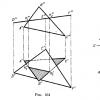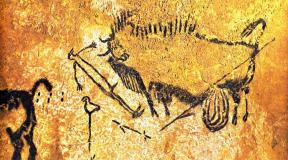"The Happy Prince and other tales. Oscar Wilde “The Happy Prince” Oscar Wilde the Happy Prince main characters
Genre: literary fairy tale
The main characters of the fairy tale "The Happy Prince" and their characteristics
- Martin. Kind, sympathetic, affectionate, faithful.
- Happy Prince. Merciful, compassionate.
- Beautiful statue
- Swallow and reed
- Strange drop
- Ruby for the seamstress
- Sapphire for the writer
- Sapphire for a girl
- The Blind Prince
- Gold for the poor
- Death of the Swallow
- Broken Heart
- Demolished statue
- In paradise
- The swallow sat down near the feet of the statue of the Happy Prince, and a tear fell on her.
- The Swallow took the ruby from the Prince's sword to a poor seamstress with a sick child.
- The swallow gave the sapphire to the young hungry writer
- The swallow gave the second sapphire to the poor girl.
- The swallow gave the gold to the poor and died of cold.
- The prince's heart broke, the statue was demolished, and the Lord took the heart and the dead Swallow.
Love for other people should be stronger than love for yourself.
What does the fairy tale "The Happy Prince" teach?
The fairy tale teaches compassion and mercy, teaches not to remain indifferent in the face of someone else's grief. Teaches kindness and selflessness. Teaches you to give alms, to share everything you have. Teaches you to love your neighbor as yourself.
Review of the fairy tale "The Happy Prince"
This is a very touching tale about a kind Swallow and a merciful Prince. They gave their lives to make people in the city happy, and that's wonderful. With their feat they deserved eternity in paradise.
Proverbs for the fairy tale "The Happy Prince"
Whoever does good will be rewarded by God.
A good deed nourishes both soul and body.
The good die, but their deeds live.
A kind heart hurts over someone else's misfortune.
To the good - good memory.
Read a summary, a brief retelling of the fairy tale "The Happy Prince"
On the column stood a statue of the Happy Prince. It was trimmed with gold, the prince's eyes were made of sapphires, and the prince's sword was decorated with a ruby.
Everyone around admired the statue and considered the prince to look like an angel.
One day, the Swallow made friends with a reed. She fell in love with the thin plant and circled around the reed all summer. Her friends had already flown to Egypt, and the Swallow was also about to fly away. She flew to the city and settled down to rest at the feet of the Prince’s statue.
Suddenly a heavy drop fell on her. The swallow was surprised, because there was not a cloud in the sky. But it turned out that it was the statue crying.
The Swallow asked the Prince why he was crying, and he said that while he was alive, he lived in the palace and had fun at balls. When he died they put him on a column, and now he sees all the poverty and pain of his people. That’s why he cries, despite the fact that he has a heart of tin.
The prince said that he saw a poor woman, a seamstress, who was embroidering a beautiful dress, and her son was lying sick and would soon die. And the Prince asked the Swallow to take the ruby from his sword to the seamstress.
The Swallow was cold and was in a hurry to go to Egypt, but the Prince so persistently persuaded the bird that the Swallow agreed. She took the ruby and took it to the seamstress's room.
When she returned, she said that she was not cold at all, and the Prince explained that it was because she had done a good deed.
The next evening, the Swallow announced to the Prince that she was flying to Egypt, but he again began to ask her to stay. He told about a hungry young man who did not have the strength to finish the play, and asked the Swallow to take the sapphire from his eye to the young man.
The swallow agreed and took the sapphire to the young man, and in the evening returned to the prince. She said that she was flying to Egypt, and that in the spring she would bring the Prince stones even more beautiful than those that he had given to the poor.
But the Prince again began to persuade the Swallow to stay. He told her about a little girl who had dropped and wet matches and was now crying because her father would punish her severely. The Prince asked the Swallow to give the girl the second sapphire. The swallow dropped the sapphire into the girl’s hands and she laughed.
And the Swallow returned to the Prince and said that she would stay with him forever, because he had become blind. She settled down at his feet and spent the whole day talking about distant and wonderful lands.
And then the Prince asked her to fly around the city and tell her what she saw.
The swallow flew around the city and told the Prince about poverty and hungry children. And the Prince asked to strip all the gold from him and give it to the poor.
Winter has come. The swallow was very cold and survived on crumbs of bread. And then I realized that I was dying. She climbed onto the Prince's shoulder and began to say goodbye to him.
The prince said that he was happy that the Swallow was finally flying to Egypt and asked to kiss him on the lips, because he fell in love with the swallow. The Swallow replied that it was not flying to Egypt, but to the abode of death and kissed the Prince.
And then the Swallow fell dead at his feet. There was a terrible crack; it was the Prince's tin heart breaking.
In the morning the mayor said that the statue looked shabby, the gilding had come off, the eyes had fallen out, and the ruby had been lost. A dead swallow lay at the feet of the statue and the head ordered that birds should be prohibited from dying near the statues.
The statue was demolished and melted down. Only the tin heart did not want to be melted down, and it was thrown into a landfill, where the dead Swallow already lay.
And the Lord sent his angel to the city, telling him to bring the most precious thing. And the angel brought a dead bird and a tin heart. And the Lord praised his choice, saying that the bird would forever chirp in his paradise gardens, and the Happy Prince would forever praise the Lord in his golden palace.
Oscar Wilde is an Irish writer known for his apt, ironic statements. He was called a master of artistic expression. Bright epithets, unusual metaphors, skillfully selected allegories and strong repetitions that Oscar used in his works seem to blur the line between painting and prose. One of the distinctive features of fairy tales written by the Irish writer is the skillful precision of phrases.
Oscar Wilde's works have a well-thought-out moral component. Some of the most famous fairy tales of the Irish author are: “The Happy Prince”, “Star Boy”. The main character of the work “Star Boy,” a poor woodcutter, decided to bring into his home an unusual baby, on whose neck an amber necklace shone with a bright light. He found it at the site of a star fall in a dense forest.
No less interesting and exciting is the fairy tale “The Happy Prince”. This work tells about a statue that was located above the city, on a high column. The Prince's sculpture was decorated with gold and covered with expensive precious stones. All the people passing by froze in admiration at one glance at the magnificent statue.
One day a lone swallow flew near the city. She recently broke up with her beloved reed. Unfortunately, the reed did not share the bird's desire to travel. She was much closer to the company of the Wind.
The swallow decided to spend the night between the statue's shoes. But the bird never managed to fall asleep. The bitter tears of the Happy Prince dripped onto her. The statue had a tin heart. But even it was painfully compressed by the memories of the poverty and misfortunes of the inhabitants of this city.
The sympathetic swallow did not fly to Egypt as planned. At the request of the prince, she carried the jewelry that was on the sculpture to the poor and pained people. The poor seamstress, an unhappy mother, whose son was seriously ill, was gifted with a ruby from the statue’s sword. The young playwright, vegetating in poverty and uncertainty, received a sapphire, which had previously been one of the eyes of the statue. The second eye of the sculpture went to an unfortunate girl, shaking with sobs, who accidentally dropped matches intended for sale into a ditch.
Winter has come. But the faithful bird did not leave the statue. She warmed the tin heart of the statue with her warm stories about Egypt, to which she so wanted to fly earlier.
Gradually, one leaf at a time, the bird removed all the gold that previously covered the sculpture. It also went to a good cause - helping the poor living in this city.
After the death of a swallow frozen from the cold, the tin heart split into two parts due to severe frost. And the authorities decided to melt down the article, which seemed ugly to them. The head of the city insisted that a monument to him personally should be erected. But the advisers opposed this decision, and disputes arose. Meanwhile, the dead swallow and the tin heart of the Happy Prince ended up in a landfill. An Angel decided to take them from there. He was looking for the most valuable things in the city and chose a dead bird and the inanimate heart of a statue that was not indifferent to human suffering.
Class: 6
Presentation for the lesson
Back Forward
Attention! Slide previews are for informational purposes only and may not represent all the features of the presentation. If you are interested in this work, please download the full version.
Lesson type: learning new material
Methods:
- explanatory and illustrative method (the teacher’s word as a necessary element in the lesson system for studying educational material, the students’ message as the implementation of the role distribution of the material);
- creative reading method (expressive reading of scenes and episodes of a fairy tale);
- heuristic method (conversation on teacher issues, observation);
- problem-search (solving problematic issues);
Equipment and materials:
- computer with licensed software:
- OS MS Windows XP
- MS Office
- projector;
- Presentation
- “Writer’s Corner”: portrait, books, illustrations for works, views of London, O. Wilde’s homeland;
text of O. Wilde's fairy tale “The Happy Prince”; - handout material.
Target: by revealing the ideological content of the fairy tale, contribute to the formation of the ability to see the artistic originality, depth, and humanistic pathos of the work.
Tasks:
- Educational– use the content of O. Wilde’s fairy tale “The Happy Prince” to expand the semantic field of the most important moral concepts “goodness”, “mercy”, “humanity”, “happiness”.
- Developmental– development of skills in analyzing works of small prose form, skills in analyzing works of painting, cinema (development of skills to analyze, contrast, compare, highlight the main thing, select arguments to confirm one’s own position, formulate conclusions; development of communication skills and abilities to apply knowledge in a new situation).
- Educational– contribute to the education of kindness and mercy, forecasting the consequences of one’s actions, and the development of readiness for social interaction.
Planned results:
- Personal results:
- development of independence and personal responsibility for one’s actions based on ideas about moral standards, social justice and freedom;
- fostering goodwill and emotional and moral responsiveness, understanding and empathy for the feelings of other people; development of initial forms of regulation of one’s emotional states.
- Meta-subject results:
- mastering the ability to accept and maintain the goals and objectives of educational activities, as well as to find means of its implementation; the ability to carry out information search to complete educational tasks;
- mastering the skills of meaningful reading of text, conscious construction of speech utterances in accordance with communication tasks;
- mastering the logical actions of analysis, synthesis, comparison, generalization, classification, establishing analogies and cause-and-effect relationships, constructing reasoning, referring to known concepts;
- willingness to listen to the interlocutor, conduct a dialogue, recognize the possibility of the existence of different points of view and the right of everyone to have their own; express your opinion and argue your point of view and assessment of events;
- determining a common goal and ways to achieve it, the ability to agree on the distribution of roles in joint activities; adequately assess your own behavior and the behavior of others.
- Subject results:
- a deep understanding of the ideological content of the fairy tale, its artistic originality, depth, and humanistic pathos of the work;
- awareness of the value of morality and spirituality in human life.
Key concepts: goodness, morality, happiness, compassion
PROGRESS OF THE LESSON
1. Organizational moment. Identification of perception, motivation
- Hello! Have a seat! Are you ready for the lesson? Then we can begin...Close your eyes for a minute, smile, open your eyes, look: our class has become lighter. When you smile, you have a happy and kind face.
– Today we have a difficult lesson ahead of us, you and I will comprehend the world of the human soul, evaluate actions, try to evaluate them, which is always very difficult to do. Let's try to find the answer to the question: “Doing good is happiness?..” May this lesson bring you the joy of new discoveries, the joy of learning.
2. Analysis of Oscar Wilde's fairy tale “The Happy Prince”. Conversation with students
“On a high column above the city stood a statue of the Happy Prince. The prince was covered from top to bottom with leaves of pure gold. Instead of eyes he had sapphires, and a large scarlet ruby shone on the hilt of his sword,” - this is how the fairy tale of the English writer Oscar Wilde “The Happy Prince” begins.
Questions that help open the reader's perception
- You have all read the fairy tale. Share your impressions about it. What did it make you think about? How did your parents answer these questions? (The fairy tale cannot leave anyone indifferent. It is permeated with the idea of goodness and mercy. Children like the main characters - the Happy Prince and the Swallow, the unexpected plot, the beauty of the language. They feel the sad tone of the story, in which goodness still rises above indifference and callousness).
– Express in one word – a noun – what you felt after reading. (Goodness, happiness, pain, poverty, suffering, mercy, love, compassion, the meaning of life, hope, joy, sadness, indifference, anger)
– As homework, you had to prepare a dictionary entry for the key concepts of the lesson. Introduction to the words “kindness” and “compassion”. (Students read the dictionary entries of the proposed words).
Good – everything good, positive, aimed at good (opposite: evil). Synonyms: benefit, benefit, charity, donation, service, favor.
Compassion - sympathy, pity caused by someone's suffering or misfortune. Synonyms: participation, pity, regret, mercy, sympathy, condolences, humanity, compassion, compassion.
(“Big Explanatory Dictionary of the Russian Language” by A.S. Kuznetsov, “Dictionary of Synonyms of the Russian Language” by M.R. Lvov).
– Watch a fragment of the animated film “The Happy Prince.” What technique is the beginning of this story based on? Who do we see in this city? (The beginning of the story is built on an antithesis - opposition. Against the background of the beauty and splendor of the statue of the Happy Prince, we see poor, homeless people overwhelmed by grief, suffering, hopelessness, and illness).
– Why did people call the statue the Happy Prince? (He was very handsome and “covered from top to bottom with leaves of pure gold. Instead of eyes he had sapphires, and a large scarlet ruby shone on the hilt of his sword.” Sparkling stones and gold attracted the eyes of people, and the Prince seemed to them the embodiment of happiness and prosperity. Later The prince will say: “People, as long as they live, think that there is happiness in gold”).
“But during his lifetime he was called the Happy Prince.” Read expressively how the hero himself talks about it. (When I was alive and had a living human heart, I did not know what tears were,” the statue answered. “I lived in the palace of San-Souci (Palace of Carelessness), where sorrow is forbidden entry. During the day I amused myself in the garden with my comrades , and in the evening I danced in the main hall. The garden was surrounded by a high wall, and I never thought to ask what was happening behind it. Everything around me was so luxurious - “The Happy Prince” - those close to me called me, and indeed I was happy. , if only happiness lies in pleasures).
– When did the Prince stop being carefree and joyful? (That’s how I lived, and that’s how I died. And now, when I’m no longer alive, they put me here, at the top, so high that I can see all the sorrows and all the poverty that exists in my capital. And although I now have a heart tin, I can't stop crying).
– What did he see from the height of his column? Let's re-read his stories about his city.
(Against the background of the music of A. Vivaldi’s concert “Winter”, part 1, excerpts are heard).
There, far away, in the alley, I see a wretched house,” the statue continued in a quiet melodic voice. – One window is open, and I can see a woman sitting near the table. Her face is haggard, her hands are rough and red, they are completely pricked with a needle, because she is a seamstress. She embroiders passion flowers on the silk dress of the most beautiful of the queen's ladies-in-waiting for the next court ball. And in the bed, closer to the corner, is her sick child. Her boy lies with a fever and asks to be given oranges. The mother has nothing, only river water. And this boy is crying.
There, far away, outside the city, I see a young man in the attic. He bent over the table, over the papers. In front of him are wilted violets. His lips are as red as garnets, his black hair is curly, and his eyes are large and dreamy. He is in a hurry to finish his play for the theater director, but he is too cold, the fire has burned out in his hearth, and he faints from hunger.
Down on the boulevard,” said the Happy Prince, “is a little girl with matches. She dropped them in a ditch, they were ruined, and her father would kill her if she returned without money. She's crying. She has neither shoes nor stockings, and her head is bare.
(On display are paintings by F.S. Zhuravlev “Beggar Children”, 1860s, V.G. Perov “Children in the Cemetery”, V.G. Perov “At the Frozen Fountain”, 1865, “Sleeping Children, 1870, I. M. Pryanishnikov “Seamstress”, 1870).
– Look at reproductions of paintings. What does this realistic painting have in common with the Prince's stories about the city? (The suffering of people, poverty, the poverty of people who are exhausted from hunger, cold, disease - this is the single motif of fairy tales and paintings that reflect social reality. In many ways, the Prince’s stories do not look at all fabulous, but rather close to reality and very skillfully woven into the fabric fairy tales).
– Which country is opposed to a gloomy, cold and homeless city? Does he tell the Prince about her? (The Swallow constantly talks about Egypt as a happy and rich country).
– Let’s reread the stories about Egypt. Why is he attractive? (Against the background of the music of A. Vivaldi’s concert “Winter”, part 2, excerpts are heard).
My friends are circling over the Nile and talking with lush lotuses. Soon they will fly to spend the night in the tomb of the great king. There he himself, Pharaoh, rests in his luxurious coffin. He is wrapped in yellow cloth and embalmed with fragrant herbs. His neck is entwined with a pale green jade chain, and his hands are like autumn leaves.
Tomorrow my friends will fly to the second rapids of the Nile. There hippos lie among the reeds, and the god Memnon sits there on a great granite throne. All night he looks at the stars, and when the morning star shines, he greets her with a joyful cry. At noon, yellow lions go to the river to drink. Their eyes are like green beryls, and their roar is louder than the roar of a waterfall.
And in Egypt there is a warm sun on the green palm trees, and crocodiles stretch out in the mud and lazily look around. My friends are already making nests in the Baalbek Temple, and white and pink doves are looking at them and cooing.
Warm, bright, soft music by Vivaldi enhances the feeling of harmony and light.
(The paintings by D. Roberts “Giza. The Pyramids of Cheops and Khafre”, “The Colossi of Memnon”, “The Great Sphinx”, J.-L. Jerome “Camels at the Source” are on display).
– Look at reproductions of paintings dedicated to Egypt. Is the Egypt that the artists created on their canvases similar to the one that the Swallow talked about? (It’s similar. It’s just as bright, mysterious, warm, full of wonders. Egypt is warm, there’s a lot of greenery, birds and animals, and they all live in peace among peace, sun, ancient temples and royal tombs).
– A wonderful country from some kind of dream... It is completely different from that terrible city in which, by the will of fate, the Swallow ended up. Why didn't she fly away? (At first she felt sorry for him, because he so wanted to help people, but was motionless and helpless, and she had a “kind heart.” And then, when, at his request, she pecked out the sapphire eyes, she said: “Now that you are blind, I will stay with you forever.” A huge feeling of love did not allow the Swallow to fly away).
– The Happy Prince says: “The most amazing thing in the world is human suffering.” Why do people live in the city who feel bad? Why are they suffering? (Everything in the city belongs to the rich. They are the masters of life, profiting from other people’s misfortune, at the expense of others. Remember the girl from the beautiful palace who reproaches the poor, exhausted seamstress for laziness, the policeman who mercilessly drives beggar children out into the rain).
- Let's listen to the most important people in the city. (Students read an excerpt from a fairy tale expressively by role).
Early in the morning, the mayor of the city was walking down the boulevard, and with him were the city councilors. Passing by the Prince's column, the head looked at the statue.
- God! What a ragamuffin this Happy Prince has become! - exclaimed the mayor.
- Exactly, exactly the ragamuffin! - echoed the city councilors, who always agreed wholeheartedly.
And they approached the statue to examine it.
“The ruby is no longer in his sword, his eyes have fallen out, and the gilding has come off,” continued the mayor. - He is worse than any beggar!
- Exactly, worse than a beggar! – city councilors confirmed.
“And some dead bird is lying at his feet.” We should issue a decree: birds are not allowed to die here.
And the secretary of the city council immediately entered this proposal into the book.
And they toppled the statue of the Happy Prince.
“There is no longer beauty in it, and therefore there is no benefit!” - said a professor of aesthetics at the university.
And they melted the statue in a furnace, and the head convened the city council, and decided what to do with the metal.
- Let's make a new statue! - suggested the mayor. – And let this new statue depict me!
- Me! - said each adviser, and they all began to quarrel.
I recently heard about them: they are still quarreling to this day.
– How do the city authorities appear? (Insensitive, cruel, arrogant, vain).
“It’s hard to live in such a city.” How does the Happy Prince decide to help disadvantaged people? (A fragment from an animated film is shown).
He said to the Swallow:
- I'm all gilded. Take my gold, sheet by sheet, and give it to the poor. People think that happiness is in gold.
“The ending of the fairy tale is tragic: the Swallow dies from the severe cold,” and at that very moment a terrible crash was heard from inside the statue, as if something had exploded there. It was a tin heart that broke.” Watch two cartoon clips depicting this tragedy. Which of the endings do you think is the most striking? Why?
– Why did the Prince’s heart split? The author puts it this way: “It was truly a severe frost.” Do you also think that the cold is to blame for everything? (No. The Happy Prince’s heart broke the very minute the Swallow died. He could not bear this grief).
– And yet our heroes are happy. Why? (They are happy because they sacrificed themselves for the sake of others. Remember, the Swallow, telling the Prince about how she helped the seamstress and her child, says: “And it’s strange... although it’s cold outside, I’m not at all cold now.” And the Prince explains to her : “This is because you did a good deed!” In goodness there is the power of joy and happiness).
– At the beginning of the lesson, we asked ourselves the question “Doing good is happiness?..” Or maybe happiness is in gold, as people who lived in the city believed, or in pleasure, as the Prince thought until he touched people’s grief ? Try to answer it now that the conversation about the fairy tale is coming to an end. (Of course, this is happiness - doing good. He who does good to another does good to himself. E. Rotterdam. Remember some good deed you did, and the feeling you experienced at the same time. You felt good, warm, joyfully, you were happy that you were able to be needed by someone in difficult times).
– Why is it necessary to rush to do good deeds? (You need to hurry to do good deeds in order to be in time, so as not to be late to provide help to those who need it right now, and not tomorrow or sometime later. It may be too late).
– At the beginning of the lesson we learned about the words “kindness” and “compassion”. Analyzing the fairy tale, we came to such concepts as “happiness” and “morality”. ( Students become familiar with words).
Moral –
1. Internal (spiritual and emotional) qualities of a person, based on the ideals of goodness, justice, duty, honor, etc., which are manifested in relation to people and nature.
2. A set of norms and rules of human behavior in society and nature, determined by these qualities. Synonyms: morality, good behavior, virtue, integrity, good character, nobility, chastity.
Happiness – a state of absolute satisfaction with life, a feeling of highest pleasure and joy.
– What do you think of the writer who created such a wonderful fairy tale? (He is kind, sensitive, sympathizing with the poor and condemning the rich; for him, it is not material goods that are valuable, but Goodness, Compassion, Mercy.)
– Unfortunately, it was not always like this. When he created his fairy tales, he was not the same as he appears to us from them: he only wanted to be seen that way. But it will become so after difficult trials. Listen to a short story of his life: “In November 1895, the famous English writer Oscar Wilde was brought from London in hand shackles to Reddington Convict Prison. He was sentenced to several years in prison for "violation of morality."
At the Redding train station, a crowd of curious people gathered around Wilde. The writer, dressed in a striped prison jacket, stood in the cold rain, surrounded by guards, and cried for the first time in his life. The crowd laughed.
Until then, Wilde had not known tears or suffering. Until then he had been a brilliant London dandy, a slacker and a brilliant talker. In the evenings he appeared in clubs and salons; these were the best hours of his life. Wilde did not want to notice the social injustice that England is so rich in. At every encounter with her, he tried to drown out his conscience and ran away to his books, poems, the spectacle of precious paintings and stones.
After the trial it was all over. Friends recoiled from him, books were burned, his wife died of grief, children were taken away, poverty and suffering became the lot of this man.
In his prison cell, Wilde finally understood the meaning of grief and social injustice. Now he wrote: “The poor are wise. They are more compassionate, more affectionate, they feel more deeply than we do. When I get out of prison, if I don’t get anything from the houses of the rich, the poor will give me something.” He touched human suffering with his heart - just like his wonderful hero the Happy Prince. And accusatory articles appeared in the writer’s work.
Shortly after his release from prison, he died in self-imposed exile in Paris. He died in poverty, forgotten by England, London and friends. Only the poor people of the neighborhood where he lived followed his coffin.”
– Concluding our lesson, I want to tell you that you need to learn to do Good, to grow in spirit, without waiting for trials. And the good fairy tales of Oscar Wilde, carrying the light of Goodness and Love, will help you with this. Learn from his heroes Compassion, Mercy, Selflessness and rejoice in your need to do Good. (The teacher demonstrates Wilde's books from the exhibition).
3. Homework(Individual assignments are offered to students in groups)
- Together with your parents, formulate the basic moral rules that you will adhere to in your life.
- Together with your parents, create the illustration “Goodness and beauty are the basis of our world.”
- Choose proverbs that reflect the content of O. Wilde’s fairy tale “The Happy Prince”.
4. Reflection
- During the lesson I worked actively/passively
- I am satisfied / not satisfied with my work in class
- The lesson seemed short/long for me
- During the lesson I was not tired / tired
- My mood has gotten better / worse
- The lesson material was clear/not clear to me, useful/useless, interesting/boring, easy/difficult
5. Lesson summary
Evaluation of students' work. As a reminder of our lesson, let you have the Happy Prince and the Swallow. (Each student receives a picture with poems).

Literature
- World literature of the 19th and 20th centuries. Encyclopedia for children. Volume 15. Part two. – M.: Avanta, 2001. – P. 97-101.
- Zhigmitova S.B. Development of an extracurricular reading lesson based on O. Wilde’s fairy tale “The Happy Prince”.// http://www.proshkolu.ru/user/Shigmitowa73/folder/142545/
- Karpova R. Kh In search of a happy person according to O. Wilde’s fairy tale “The Happy Prince”.// http://collegy.ucoz.ru/load/12-1-0-2704
- Paustovsky K.G. Oscar Wilde. //Literature lessons. Supplement to the magazine “Literature at School”, No. 11, 2006. – P. 1-2.
- Tamarina T. Happiness is doing good. Lesson on Oscar Wilde's fairy tale “The Happy Prince” // Literature lessons. Supplement to the magazine “Literature at School”, No. 11, 2006. – P. 3-7.
- Wilde O. Star boy. Fairy tales/The Happy Prince (translation by K. Chukovsky). – Sverdlovsk: Central Ural Book Publishing House, 1979.
- Happy Prince. Animated film. Directed by N. Lerner. Animation film studio. Creative association "Ekran". 1992 // http://allmults.org/multik.php?id=1837
- Happy Prince. Animated film. Directed by L. Zarubin. Ukrainian animation film studio. 1990 // http://teramult.org.ua/mult/1990_ua_schastlivyj.princ
Appendix 1
Impression of O. Wilde’s fairy tale “The Happy Prince”
Rybin family
Mikhail, 6th grade student
“For me, Oscar Wilde’s fairy tale is dramatic. It shows compassion, grief and social injustice. The tale is very true, comparing the lives of the poor and the rich. This fairy tale once again made me think about the fact that you need to do good, and it will come back.”
Mother
“O. Wilde’s fairy tale “The Happy Prince” made a deep impression. This fairy tale is sad, sad, about the meaning of life. The prince lived his entire life in wealth and prosperity. Only after death, already as a statue, he realized that “the most amazing thing in the world is human suffering. There is no miracle more wonderful than need.” To help poor and needy people, the Happy Prince and the Swallow sacrificed themselves, but people did not appreciate it. And only the angel brought the most valuable things to the Lord: a tin heart and a dead Swallow.
This fairy tale makes you think about the meaning of life, good and evil, compassion, the cruelty of people, and morality. This is a very deep and instructive tale that should be read by both children and adults.”
Shubin family
Alexander, 6th grade student
“Oscar Wilde's fairy tale “The Happy Prince” made a great impression on me. This is a very small, but very sad and touching fairy tale. The author wrote about the little Swallow, who, instead of flying to Egypt, stayed with the Happy Prince in the winter and carried out his instructions until she froze and fell dead from the cold at his feet.
The author makes us think about the fact that we need to help each other in trouble, be able to sympathize, have compassion, and bring goodness into the world, so that the world becomes better, warmer, brighter, more joyful.”
Mother
“The fairy tale “The Happy Prince” by Oscar Wilde made a great impression. This tale is about love and suffering. It glorifies high human feelings, sounds the motive of sacrifice, nobility, death in the name of love, in the name of the life of another being. The entire work is permeated with light and pain, in it true beauty appears inseparable from generosity and self-sacrifice. The fairy tale makes us think about such eternal concepts as good and evil, love and friendship, devotion and compassion.”
Yudin family
Vyacheslav, 6th grade student
“This fairy tale is very interesting. When I read the fairy tale to the end, I imagined myself as a happy prince. The fairy tale makes you think about the need to help poor people and never refuse help, to believe in friendship.”
Mother
“The fairy tale turned out to be a kind and wise teacher not only for children, but also for adults. When you read it, it evokes only positive feelings and qualities that a person can apply if he wants. Teaches you to be brighter and kinder in our difficult world, how to become caring and not embittered towards other people. Makes you think about what kind of person you want to become and whether you can. Shows examples from life that are found in our time. The more such people there are, with such positive qualities, then, probably, everything around us will be kinder and better.”
Lokhov family
Sergey, 6th grade student
“I really liked this fairy tale. She is filled with kindness and love. If most people were like this, Russia would be a better place. The fairy tale made me think that there are people who can sacrifice themselves for poor people and die of love.”
Dad
“The fairy tale made a great impression on me. I felt sorry for the bird and the happy prince who died of love. And this fairy tale made me think about the fact that you need to take care not only of yourself, but also of others.”
Nikolaev family
Svetlana, 6th grade student
“I really liked this fairy tale. She's instructive. Causes a feeling of pity for poor people. Once they erected a monument to the Happy Prince made of pure gold. He had a soul and a kind heart, which is why the Swallow loved him so much. They stayed together forever. They soon died, but the Prince’s kind heart and the Swallow’s love remained in peace.”
Mother
“After reading the fairy tale “The Happy Prince” I was touched. The fairy tale has such a deep meaning that it really touches the soul, makes you think about the fact that there are people who die of hunger and cold, and live in poverty. The fairy tale evokes a feeling of mercy, compassion for poor people, and a desire to help one’s neighbor. It’s somehow simultaneously sad that the prince and the swallow are dying, and joyful that the soul and kind heart remained to live forever.”
Baburov family
Evgeniy, 6th grade student
“The story is sad. Makes you think about courage and kindness.”
Mother
“The tale is very interesting. Makes you think about kindness and mercy.”
Khrisanov family
Sergey, 6th grade student
“I really liked the tale of the Prince and the Swallow. They were generous and kind. The swallow had to fly to Egypt, but she stayed and helped poor people. I advise everyone to read this fairy tale because it is very good.”
Mother
“The fairy tale “The Happy Prince” has a hidden meaning. First, the author introduces us to the golden statue, then to the swallow. Everyone has their own destiny. When they meet, they become friends. The prince tries to help poor people with his gold, and the swallow becomes his companion. But in the end both die. They are thrown away like trash. This tale is about strong friendship, the generosity of a prince, and the devotion of a swallow. And then about the indifference of people who saw only gold and jewelry in the prince. But no one ever found out that he had, although a tin, but a living heart.”
Gorlinsky family
Alexandra, 6th grade student
“The fairy tale made me think about kindness and love. Every person knows how to cry and suffer. You need to think not only about yourself, but also about the unfortunate people, what it’s like for them.”
Mother
“We must appreciate and love loved ones. Only then do you begin to understand, when you can no longer help, we ask others to do it, although we could do it ourselves.”
There are fairy tales for the little ones. There are fairy tales just for little ones. There are fairy tales for schoolchildren. And there are fairy tales that everyone should read, regardless of age - they are so beautiful and at the same time incredibly life-like, and every phrase is filled with meaning. It was these tales that the Irish writer and playwright Oscar Wilde became famous for. His fairy tales “The Infanta's Birthday”, “The Fisherman and His Soul”, “The Star Boy” and others are striking in depth and mesmerizing.
The fairy tale “The Happy Prince” is one of Wilde’s most famous fairy tales and, perhaps, one of the few of his works that is distinguished by optimism, even despite the rather sad ending. And in order to understand for whom it was written, and to remember the true values, I want to re-read it again and again.
A little about the author
Oscar Wilde is one of the most controversial figures in world literature. A unique playwright, an excellent essayist and the author of many journalistic essays, whose work was filled with paradoxes and generously seasoned with brilliant wit and an incredibly subtle sense of linguistic nuances.
Wilde can safely be called a master of artistic expression: his lush epithets, flowery metaphors and allegories, strong and precise repetitions, impeccable precision of phrases seem to blur the lines between literature and painting.
Oscar Wilde is a prominent representative of the philosophy of aestheticism, a movement in art of the 19th century that recognized beauty as the only possible truth, and hedonism and sensual pleasures as the most correct way of life. For supporters of aestheticism, art should neither instruct, nor teach, nor have any complex content. Its essence is the predominance of the external over the internal, the priority of beauty, sophistication and sophistication of the shell. Wilde not only shared the views of aesthetes, but also tried to convey the essence of his philosophy to all outstanding writers and representatives of the art of Europe. All the more paradoxical are the features of the fairy tales that came from his pen.
In total, Wilde owns two collections of fairy tales: “The Happy Prince and Other Tales,” first published in 1888, and “The House of Pomegranates,” published in 1891. The uniqueness of these tales lies in the fact that under the impeccable and exquisite turns of phrase and luxurious descriptions lies a truly deep meaning and an attempt to convey to readers a certain morality, emphasizing the exceptional importance of spiritual values, which is, in general, not characteristic of aestheticism. Perhaps the writer was driven solely by paternal feelings (he composed fairy tales for his sons, Vivian and Cyril), which forced him to somewhat rethink the essence of existence, or maybe it was nothing more than an extremely successful literary experiment - both versions are quite plausible. However, even today Oscar Wilde’s fairy tales have not lost any of their relevance.
"The Happy Prince" Enchantments and Paradoxes
 If you read the fairy tale for the first time, you might inevitably think that it belongs to the pen of Hans Christian Andersen, since the plot outline is surprisingly similar: a talking swallow flying away to warmer lands, a statue that can think and feel, self-sacrifice and selflessness of the main characters, sad, but at the same time At the same time, there is a surprisingly bright ending, a clearly visible religious motive. However, the style of the work casts doubt on this: luxurious descriptions, an attraction to the splendor of the East, and a demonstration of rich language skills were characteristic of the talented Dane, but such ardent worship of the material world was not observed in him.
If you read the fairy tale for the first time, you might inevitably think that it belongs to the pen of Hans Christian Andersen, since the plot outline is surprisingly similar: a talking swallow flying away to warmer lands, a statue that can think and feel, self-sacrifice and selflessness of the main characters, sad, but at the same time At the same time, there is a surprisingly bright ending, a clearly visible religious motive. However, the style of the work casts doubt on this: luxurious descriptions, an attraction to the splendor of the East, and a demonstration of rich language skills were characteristic of the talented Dane, but such ardent worship of the material world was not observed in him.
Indeed, the art with which Oscar Wilde uses epithets is amazing: the statue of the Happy Prince is not just stone or bronze - it is gold, and even decorated with sapphires and rubies. The swallow was not just chasing a moth - it was “big and yellow”, the icicles were “brilliant crystals”, and the descriptions of Egyptian landscapes were a real feast for a literary gourmet.
At the same time, one cannot fail to note Wilde’s impeccable taste: the text does not feel overloaded, excessive, or tedious. Each word takes on relief and full form, giving rise to amazingly vivid images. And this is the secret of such success of both this and other works of the writer. The fairy tale “The Happy Prince” fascinates with the beauty and elegance of the language, which is impossible not to recognize.

As for the idea and plot, even in such a genre as a fairy tale, Oscar Wilde’s famous craving for paradoxes is manifested, and not so much in terms of content as in terms of meaning. How did the Prince, who in his entire life had not known not only grief, but more or less troubles, turn out to be so responsive and understanding after death, where did the free Swallow learn such aristocratic salon chatter, and why did she, so carefree and easy-going, suddenly decide sacrificing oneself for the sake of good - these are plot questions, the answers to which everyone can easily find: just re-read the fairy tale several times. The paradoxes of a fairy tale are in its idea.
Even though Wilde advocated the separation of art from morality and believed that literature should be more entertaining than instructive, this tale could not do without condemning human callousness and indifference, ridiculing human craving for fame and honor, praising kindness and generosity and selflessness and recognition of the soul as the highest value and basis of humanity as such. However, the paradox is that while recognizing the exceptional significance of the spiritual principle, the writer seems to deny it beauty. For some reason, the prince’s kind heart turns out to be tin, the loyal and brave Swallow is just a “dead bird” without any epithets, and the Prince was able to get to the throne of God only when he lost all his gilding.
You will probably be interested in Oscar Wilde's "Star Boy", which tells about a boy who was very handsome, but had a heart of stone in his chest.
In our next article you will find a summary of Wilde's sad fairy tale about the beautiful but heartless Infanta and the little Dwarf, who danced for her on her birthday and was not aware of his ugliness.
Wilde seems to be trying to convey to the reader the idea that the essence of beauty is just beauty, and truth and soul are always unsightly and unsightly. Why the writer rejects the idea that both form and content can be equally beautiful is a mystery. Perhaps the reason for this was the severe internal contradictions that tormented the playwright throughout his life and which he was never able to resolve when his life ended so sadly.
Why this fairy tale should be read to children

Very young children most likely will not understand this fairy tale, and older children will not fully understand it, although, perhaps, this is not necessary. The exquisite symbolism and depth of meaning were clearly not intended for children, so parents are advised not to focus on this.
In addition to the exciting and mysterious descriptions of distant lands, which are sure to enchant impressionable and receptive children's minds and hearts, little ones will certainly be touched by the sad story of the Prince and the Swallow, using the example of which it is easy to explain to a child the importance of such values as generosity, love, kindness, altruism and selflessness, which in today's society, unfortunately, is often neglected. Perhaps children do not immediately understand the meaning of the fairy tale, but it will undoubtedly touch their vulnerable souls and make them think about the structure of the world around them and the characters of the people living nearby.
Why this fairy tale should be read by adults
While the wisdom of introducing this tale to young children is questionable, adults seem to be the clear target audience for any work by Oscar Wilde. Without a doubt, his own children listened admiringly to their father’s stories - according to contemporaries, his speech was “easy, beautiful, entertaining.” But did they fully understand everything?
For those who are far from philological delights, this is a chance to get out of the shell of indifference and detachment into which most people today drive themselves, and to remember that there are always those nearby who need attention and help.
With his work, Wilde wanted to glorify His Majesty's Beauty - however, it still could not do without morality, which is actually wonderful. If everyone listens to the call carefully hidden in the fairy tale to become kinder and more humane, perhaps the day will come about which the playwright wrote in his treatise “The Soul of Man under Socialism” “when every member of society will be a participant in the general contentment and well-being.” The fairy tale "The Happy Prince", of course, is not as serious as a treatise. But its meaning is no less deep and humane.
Oscar Fingal O'Flaherty Wills Wilde
"The Happy Prince and Other Tales"
Happy Prince
Covered with gold and precious stones, the sculpture of the Happy Prince stood on a column above the city. Everyone admired the beautiful statue. One day the Starling was flying over the city - he left his beloved Reed, who was a homebody and did not share the love of travel, but only flirted with the Wind; he settled down for the night between the Prince's shoes. Suddenly the bird felt the tears of the Prince - he was crying, for he saw all the sorrow and poverty of the city, although he had a heart of tin. At the request of the Prince, the Starling did not fly to Egypt, but for several days he brought help to poor people in the form of jewelry from the sculpture: to a seamstress whose son was ill - a ruby from a sword, to a poor young playwright - a sapphire eye, to a girl who dropped matches for sale in a ditch - second sapphire.
Winter came, but the Starling decided to stay with the Prince and told him, already blind, about Egypt, where the bird itself was so eager. After the Starling distributed all the gold that covered the sculpture leaf by leaf, the winged assistant died. The Prince's tin heart was split in two.
The ugly statue was removed and melted down. The head of the city decided that it was time to erect a monument to himself, but the Councilors did not agree - everyone quarreled. The tin heart and the dead bird were thrown into a landfill, from where they were taken by an Angel, whom the Lord asked to bring the most precious thing that he would find in this city.
Boy and Giant
Every day the children played in the Giant’s beautiful garden, but when he returned from visiting, where he had stayed for seven years, he kicked all the children out of his domain, built a fence and hung a sign “No Trespassing”. The children did not find another place to play; they remembered the garden with sadness. Spring came, and only winter raged in the Giant’s garden - after all, there were no children, and there was no one for the birds to sing their songs. Even autumn bypassed the garden.
One morning the Giant heard beautiful music - it was a linnet singing. Looking out the window, he saw that the children had climbed through a hole in the dilapidated fence and sat on the branches of trees, which immediately blossomed. Only in the corner where the little boy could not climb up was winter. I saw the Giant, the children ran away - and winter came to the garden again. Only the little boy did not notice the formidable master. The giant lifted the boy onto a branch, and he hugged and kissed him.
The giant tore the fence to pieces and gave the garden to the children, and even played with them himself. When the children came to say good night, the boy was not with them, and the Giant became sad. The boy did not appear again, and the Giant became completely sad. One winter morning, the very old Giant saw that the tree in the corner of the garden was covered with beautiful white flowers, and under the tree stood the same boy, but there were gaping wounds on his arms and legs. The Giant angrily asked who did this, but the boy replied that “these are the wounds of Love” and said that His garden was open to the Giant.
When the children came to the garden, they saw the Giant lying under a tree, strewn with white flowers.
Devoted friend
One morning the old Water Rat poked its head out of its hole. The duck taught her children to stand upside down in a pond (“If you don’t learn to stand on your head, you’ll never be accepted into good society”). Water Rat: “Love, of course, is a good thing, but friendship is much more sublime... A devoted friend must be devoted to me.” Then Konoplyanka began the story of the Devoted Friend.
Once upon a time there lived a nice boy, Hans. He was no different, except that he had a kind heart and a funny, round, cheerful face. He had a garden, which he loved very much and where he grew flowers. Little Hans had many friends, but the most devoted was Big Gyu-Miller. The rich miller was so devoted to him that every time he passed by, he picked up a huge bouquet of flowers or filled his pockets with fruits. “True friends should have everything in common,” he said. And Hans carefully wrote down the entire theory of friendship in a notebook. Naturally, the miller never thanked Hans in any way. In winter, he never visited him (“When a person has a hard time, it’s better to leave him alone”) and did not invite him to his place (“... there is nothing worse in the world than envy, it will spoil anyone... I am his friend and will always make sure that he does not was tempted.")
Finally spring came and the Miller went to Hans for primroses. Hans wanted to sell them and buy back the car, which he had to pawn in the winter. But the miller took all the flowers (the basket was huge) and offered to give Hans his wheelbarrow, although it was very broken. Hans said that he had a board and would fix the wheelbarrow. Then the miller asked Hans, as a true friend to whom he was going to give a wheelbarrow, to repair the hole in his roof with this board. Hans, of course, agreed for the sake of his friend. The miller began to ask him for other “services”, because he would give him a wheelbarrow. Hans agreed to everything, but he simply did not have time to work in his garden.
One night the miller's child fell ill. I had to go get the doctor, but there was a terrible storm outside. The miller asked Hans, but didn’t even give him a lantern (“...I have a new lantern, what if something happens to it?”). On the way back, Hans lost his way and drowned in a swamp. Everyone came to Hans's funeral because everyone loved him. But Melnik was the one who grieved the most (“I, one might say, already gave him my car and now I can’t imagine what to do with it: it only takes up space at home, and they won’t give me anything to sell, it’s so broken.” I’ll be more careful. Now no one will get anything from me. Generosity is always harmful to a person.”)
The Water Rat did not understand the story and went home. “I’m afraid she’s offended by me,” said Linnet. “...I told her a story with a moral.” - What are you talking about, this is a dangerous business! - Duck."
Wonderful rocket
Everyone was preparing for the wedding of the prince and the beautiful princess, who was brought from distant Russia. The Court Engineer at the far end of the garden was preparing everything for the fireworks (the Russian beauty had never seen fireworks). Firecracker, Roman Candle and Fire Carousel discussed peace. Carousel, who in her youth fell in love with a Christmas tree box, believed that love was dead, Petard saw the world as beautiful, and Roman Candle considered it too big.
Patron, tied to a long stick, drew attention to himself with a sharp cough. No one can insert a word into his long and very selfish speech: he considered himself superior to everyone (the prince was lucky that the wedding was scheduled on the day of the launch of the Patron), he called others rude. To all the admonitions to stay dry, because this is the main thing for their brother, Patron replied that he was choosing to cry. Of course, when all the charges flew up to the sky, causing the princess to laugh, the damp Patron remained silent, and the next day the wipers threw him into the ditch.
The patron decided that he was sent to the waters to improve his health; True, he didn’t like the local society - the frog, because she only talked about herself. Despite the fact that the interlocutor had already sailed away, Patron laid out his entire story about how the wedding of a prince and princess was organized in his honor. Dragonfly and Duck also thoughtlessly and quickly left him, having lost the opportunity to grow wiser.
The boys who were collecting firewood threw a dirty pole into the fire to warm the water in the pot. The cartridge exploded, but the boys didn’t even wake up. The stick fell on the back of Goose, who took off running, and the Patron went out, having managed to say: “... I knew that I would make a splash.” Retold Mouse
Happy Prince
The sculpture of the Happy Prince towered over the city. A Starling flew past her and decided to stop for the night in the sculpture's shoes. Suddenly tears began to fall on the bird - the Prince was crying, grieving for the inhabitants of the city. From that day on, the bird began to carry jewelry to poor people that adorned the sculpture.
Soon nothing remained of the Prince’s former splendor; the Starling distributed all the most valuable things to those in need. The bird died, and the tin heart of the sculpture could not withstand this grief.
The statue was melted down and thrown into a landfill along with the dead Starling. But the Angel took them to the Lord as the greatest treasure of this city.
Boy and Giant
After his return, the Giant drove the children out of his garden. And eternal winter settled there, even birds flew past the forbidden possessions.
One morning the Giant saw that children had sneaked into one of the corners of the garden. Only where they were did the trees bloom again and the birds sing. Noticing the Giant, the children ran away, only a little boy did not catch them. When the Giant approached him, he kissed him.
Since then, the Giant has played with the children and even removed the fence. Only the little boy was not with them. And when he appeared, his body was covered with wounds. The boy told the astonished Giant that this was the price for returning His garden. Soon the children discovered the Giant under the trees. He lay covered with snow-white flowers.
Devoted friend
Konoplyanka decided to tell the inhabitants of the pond a story about a devoted friend. Hans was kind and hardworking. He loved his garden and took good care of it. His friend Gyu-Melnik often dropped in to visit Hans, but only when he could profit from something. He left home from his friend with an armful of flowers and pockets full of fruit. In winter, Melnik did not visit his friend. Why, he has nothing to take.
One spring, the Miller took from Hans all the primroses that he was preparing for sale. The proceeds had to be used to buy a car. But Melnik said that he would give him a car, and in exchange for the favor he asked to fix the roof. The series of requests lasted all summer and Hans did not have time to work in the garden.
One day the Miller asked Hans to bring a doctor for a sick child. He went, but got lost and drowned in the swamp, because his friend spared the lantern for him. All the friends cried, but Melnik shed the most tears. He was offended that his car remained out of use.
Wonderful rocket
The prince's wedding was soon to take place. His bride did not know what fireworks were, so they carefully prepared for their display. The Firecracker, Fire Carousel and Roman Candle were expected to take an active part in the spectacle.
Patron considered himself the most important person in this event. And no matter how much they tried to persuade him, he was unable to stay dry at the crucial moment. He became damp and could not adequately perform his function, for which he was thrown into a waste pit.
But the boastful Patron did not take this as a punishment. He told all the inhabitants of the ditch that he was taking water treatments. Nobody listened to the fool.
The moment of triumph for Patron came when the boys threw a burning stick into the water. There was not a loud boom that didn’t even wake up the kids. Only one Goose was scared.
Read also...
- What are the reasons for the successful military campaigns of the Mongols?
- Intersection of two planes
- Why do you dream of white doves: for the fulfillment of desires, meeting true love Seeing white doves in a dream
- I dreamed of a white dove - interpretation of the dream according to the dream book. What does it mean when you dream of a white dove



















